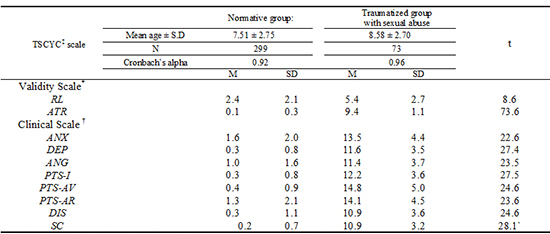Abstract
Figures and Tables
Table 1
Age and gender difference of the normative group and the traumatized group with child sexual abuse

Table 2
Coefficient alpha reliability of the TSCYC scale in the normative group and the traumatized group with child sexual abuse

TSCYC, the trauma symptom checklist for young children; no., number; RL, response level; ATR, atypical response; ANX, anxiety; DEP, depression; ANG, anger/aggression; PTS-I, post-traumatic stress-intrusion; PTS-AV, post-traumatic stress-avoidance; PTS-AR, post-traumatic stress-arousal; PTS-TOT, post-traumatic stress-total; DIS, dissociation; SC, sexual concerns.
Table 3
Reliability of the TSCYC scales by test-retest after 4 weeks (n = 88)

Pearson correlations for all are significant at the 2-tailed P<0.001 level. *r, Pearson correlation. TSCYC, the trauma symptom checklist for young children; M, mean; SD, standard deviation; RL, response level; ATR, atypical response; ANX, anxiety; DEP, depression; ANG, anger/aggression; PTS-I, post-traumatic stress-intrusion; PTS-AV, post-traumatic stress-avoidance; PTS-AR, post-traumatic stress-arousal; PTS-TOT, post-traumatic stress-total; DIS, dissociation; SC, sexual concerns.
Table 4
Intercorrelations among the TSCYC scales in the traumatized group with child sexual abuse

Pearson correlations for all are significant at the 2-tailed P<0.001 level. TSCYC, the trauma symptom checklist for young children; M, mean; SD, standard deviation; RL, response level; ATR, atypical response; ANX, anxiety; DEP, depression; ANG, anger/aggression; PTS-I, post-traumatic stress-intrusion; PTS-AV, post-traumatic stress-avoidance; PTS-AR, post-traumatic stress-arousal; PTS-TOT, post-traumatic stress-total; DIS, dissociation; SC, sexual concerns.
Table 5
Association between TSCYC and CBCL as well as CSBI in the normative group

Correlation is significant at the P<0.01 level (2-tailed) for all. RL, response level; ATR, atypical response; ANX, anxiety; DEP, depression; ANG, anger/aggression; PTS-I, post-traumatic stress-intrusion; PTS-AV, post-traumatic stress-avoidance; PTS-AR, post-traumatic stress-arousal; PTS-TOT, post-traumatic stress-total; DIS, dissociation; SC, sexual concerns; CBCL, the child behavior checklist; CSBI, the child sexual behavior inventory.
Table 6
Differences between the normative group and the traumatized group with child sexual abuse

P value<0.001 for all. N, number; M, mean; SD, standard deviation; RL, response level; ATR, atypical response; ANX, anxiety; DEP, depression; ANG, anger/aggression; PTS-I, post-traumatic stress-intrusion; PTS-AV, post-traumatic stress-avoidance; PTS-AR, post-traumatic stress-arousal; PTS-TOT, post-traumatic stress-total; DIS, dissociation; SC, sexual concerns; TSCYC, the trauma symptom checklist for young children.




 PDF
PDF ePub
ePub Citation
Citation Print
Print




 XML Download
XML Download